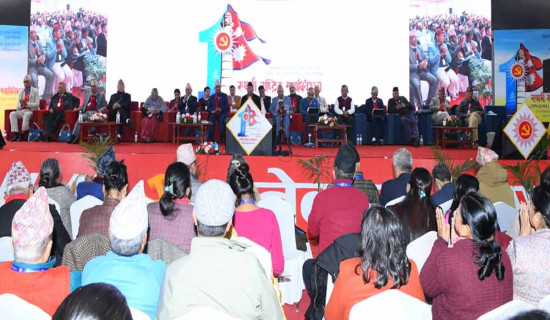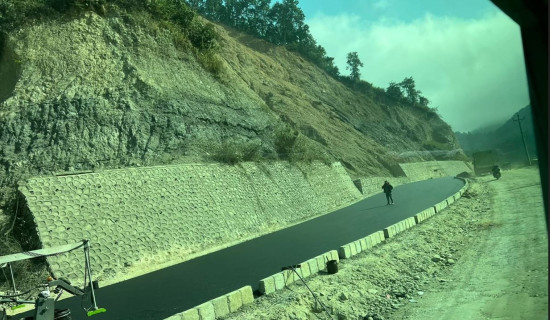- Monday, 15 December 2025
Structural Inequalities: Root Of Unjust World
“My father left our house the minute he heard I was born. He even took the packet of dry fruits he had brought for my mother, thinking that she would give birth to a son, but he then never returned,” says 23-year-old Mita from Sindhuli.
“My mother and three of us siblings were abandoned by my father when he brought a second wife. He forcefully made my mother sign the paper that stated that she had taken a share of his property. He then never contributed to our needs. I am now an adult and earning, and I have also filed a case against him for our share of property,” says 22-year-old Gita from Sarlahi. “My mother has mental health issues, and my sister, like me, is differently abled and lives with disabilities. My father abandoned all of us, and we lived with my maternal uncle. I've completed my education and applied for a school job through the government's allocation. Despite proving my teaching skills over the past two years, obstacles remain to securing the job. Now, who will help me and my family? Both the state and my father have abandoned us,” says 22-year-old Rita from Birgunj.
“During my childhood, I was sexually abused by my maternal uncle, and that pain and fear still haunt me. There are many more like me, but how do we get justice?” asks Sita.
The names of all these daughters of Nepal have been changed, but there are several facts like these all over the country and the world where girls and women have been stripped of their rights and are not getting the basic human rights that are due to them and ensured by the Declaration of Human Rights and laws promulgated in their countries.
Gender-based violence against girls and women (GBVAG&W) and the LGBTQI communities happens all over the world, whether the country has laws for their protection or not.
Yesterday I received a WhatsApp message from an Afghan woman requesting help for the ever-worsening situation of women’s human rights there, which has been wiped off by the Taliban. The structural inequalities prevalent on earth today, despite the level of advanced civilization we have achieved, still enforce discrimination against people, especially girls and women. Structural inequalities refer to the unequal distribution of resources, opportunities, and power within a society. It is caused by deeply ingrained social, economic, and political systems that have developed over time. These systems include institutions such as the legal, educational, business, government, and health care systems.
Every year, March 8 is celebrated as International Women’s Day (IWD), and the campaign theme of International Women’s Day 2024 is #InspireInclusion, while the theme of the UN observance of the day is Invest in Women: Accelerate Progress. According to the World Economic Forum’s Global Gender Gap Report 2023, it will take another 131 years to reach gender parity. As we celebrate IWD, it is important to reflect on why, even after more than a century of celebrating IWD with campaigns all over the world by governments and civil societies, we are still facing this atrocious crime against humanity.
Globally, 81,000 women and girls were killed in 2020. Around 47,000 of them, or 58 per cent, died at the hands of an intimate partner or a family member. This is an average of one death every 11 minutes. According to a World Bank report, Sub-Saharan Africa and South Asia are the two regions where the highest-known Intimate Partner Violence (IPV) is faced. In the former, 33 per cent of women aged between 15 and 49 years have suffered IPV in their lifetime, and in the latter, 35 per cent. According to World Bank data, 6 per cent of women worldwide have been subjected to sexual violence from a non-partner.
The Safer Now report released by Every Woman Treaty, which is a coalition of over 2000 women rights activists from 128 countries, documents that there is a rapid rise in VAW and girls worldwide and the current gaps in international laws to address this crisis. They state that as many as 73 per cent of the world’s women have been exposed to some form of online violence, making cyberviolence one of the most prevalent forms of VAW.
The IWD is a day when there is a global celebration of women’s rights and achievements. It started as a labour movement more than a century ago, in the early 1900s, when more than 15,000 women marched for the first time on the streets of New York to demand better working hours, pay, and voting rights for women. In 1910, a German activist, Clara Zetkin, proposed an International Women’s Day in Copenhagen, and the first IWD was held on March 19, 1911, in four European countries. Since then, the date has been changed to March 8 and observed worldwide, which was later adopted by the United Nations as its annual function.
IWD has succeeded in celebrating globally to reflect and rejoice on progress in women’s empowerment and also plans to work more to end violence against them. However, the drivers of GBVAW&Gs are very complex and multifaceted. Based on social, cultural, religious, traditional, economic, and political reasons, different communities still have ingrained structural differences that categorise people into different segments, and discrimination is a mindset that has been hard to erase.
Not only that, as human civilization advances and science and technology advance, but new forms of challenges also seem to come, which further become forms of violence and crimes against the most vulnerable on earth. As the digital age advances, cyber-crimes are increasing, and all over the world, girls and women seem to face over 70 to 90 per cent of such crimes. Artificial intelligence is supposed to be a boon to humankind, but this too has succeeded in becoming a tool of sexual harassment, where again, women face more than 92 per cent of the brunt. The power structure all over the world concerned with the manufacturing and selling of weapons, drugs, and wealth still seems to be under the control of the most powerful men and nations. This has increased the disparity in the incomes of the people, and the sad reality is that the most vulnerable people are exploited all the time, resulting in their worsening economic conditions. The wars that have raged all over the world and the weapon distribution that strengthens autocratic power-hungry leaders and nations point to the fact that today’s so-called civilised world is actually a disguise for power control.
The capitalist, neo-liberal, and patriarchal value systems have spread a web that still exploits women’s labour at all levels. The COVID-19 pandemic has also shown that this value system is so ingrained that during the pandemic, GBVAW&Gs increased in such alarming forms that the UN Women declared a shadow pandemic, indicating the rise of such violence.
There is no doubt that today’s world has more opportunities for youth. But there are more challenges too, especially as regards ensuring the rights of all but mainly girls, women, and the LGBTQI community. If the structural inequalities are not addressed properly, soon the world will be more and more unsafe for women and girls, and while celebrating IWD, we need to internalise this. Happy IWD to all my readers.
(Sharma is a senior journalist and women rights advocate.)

















